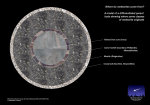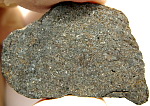| If the asteroid becomes large enough it is heated by the decay of radioactive isotopes. This can cause the various minerals and metal to melt, destroying the chondrules, and the asteroid becomes differentiated. This means that the metal sinks to the centre (due to its high density) forming a core, with other mixtures of minerals forming layers around it. Click the image on the right for BIMS member Mark Crawford's excellent illustration of a differentiated parent body.
|  |
Meteorites from these parent bodies do not have chondrules, so are called achondrites. Achondrites are divided into the following groups:
- Eucrites - Basaltic, part of the HED group thought to originate on the crust of asteroid 4-Vesta. (image shows a 1.4g part slice of NWA 1836, eucrite)
|  |
- Diogenites - Basaltic, part of the HED group thought to originate deep under the crust of asteroid 4-Vesta.
- Howardites - Basaltic, part of the HED group thought to originate on the asteroid 4-Vesta. Howardites consist of cemented fragments and clasts of eucritic and diogenite material.
- Angrites - A rare group with a relatively small number of members. It has been suggested that some Angrites may originate from Mercury, although it is considered more likely that they originated on another, as yet unknown, parent body.
- Aubrites - Often have a white interior and form a beige fusion crust unlike any other meteorite type. A famous example is Norton County, the fall of which included a 1 ton stone!
- Ureilites - Igneous rocks with a unique composition. Known to contain graphite and, in some cases, tiny nano-diamonds.
- Brachinites - Another rare group with few members.
- Planetary - meteorites thought to originate from Mars (Martian meteorites, the SNC group) or the Moon (Lunar meteorites). Other planetary parent bodies have also been considered (e.g. Mercury). (Image shows a 0.19g crusted part slice of Zagami, Shergottite, which is though to have originated on Mars)
|  |
| There are also three primitive achondrite groups (Acapulcoites, Lodranites and Winonaites) which have not undergone the same amount of melting and recrystalisation as the other achondrites. These are thought to have originated on the same (as yet unknown) parent body. (Image shows a 3.4g part slice of NWA 2871, originally classified as an acapulcoite, the grain size has suggested reclassification as a lodranite)
|  |
|

